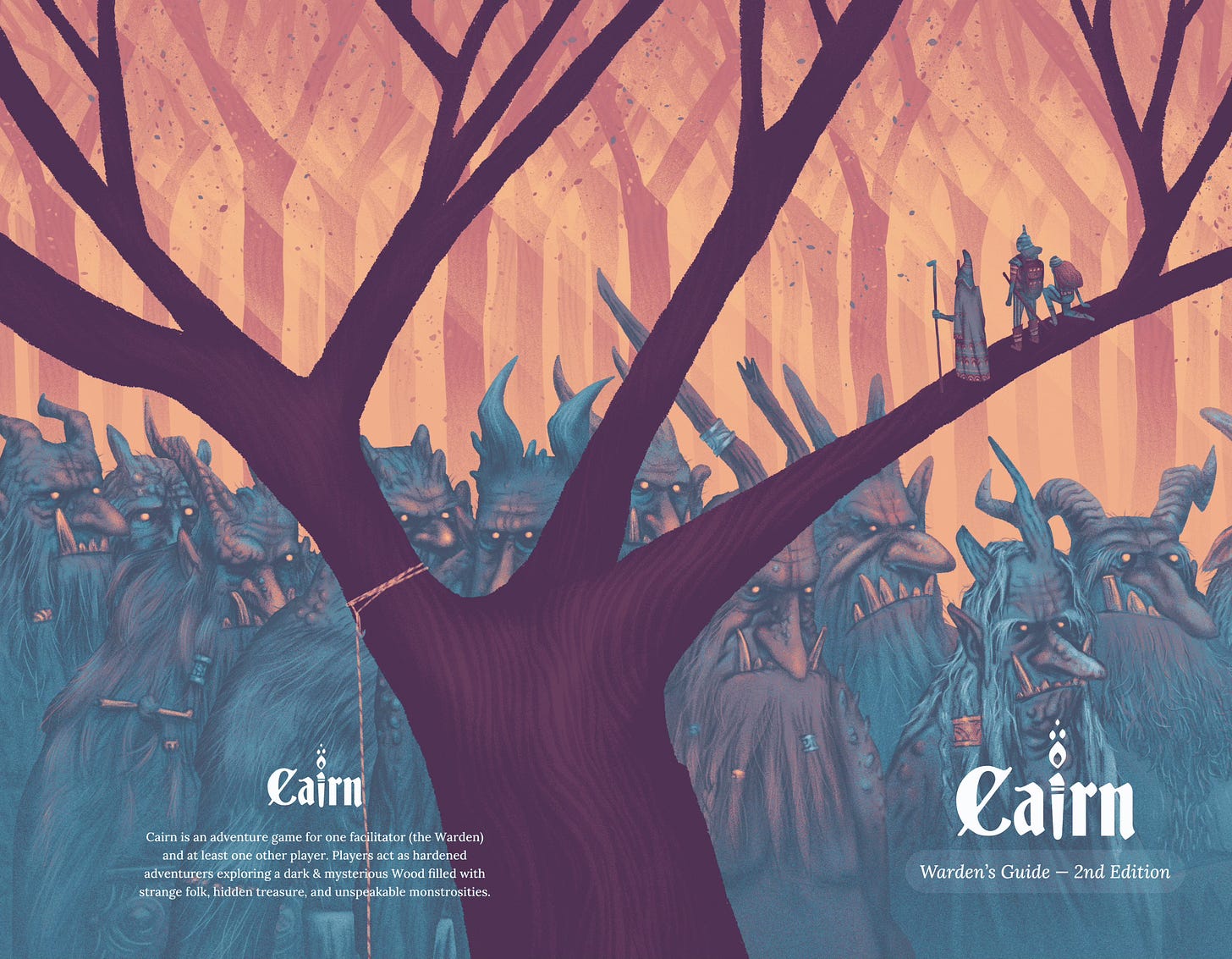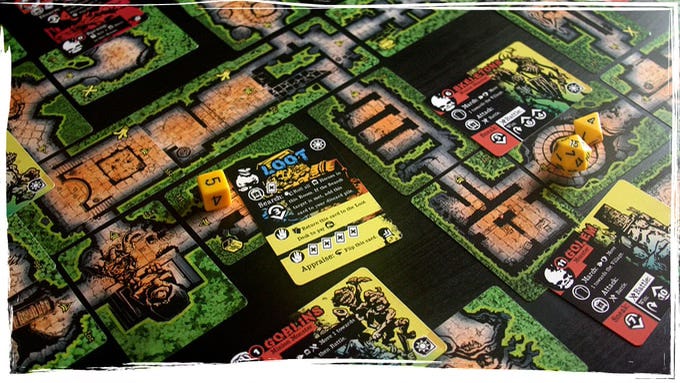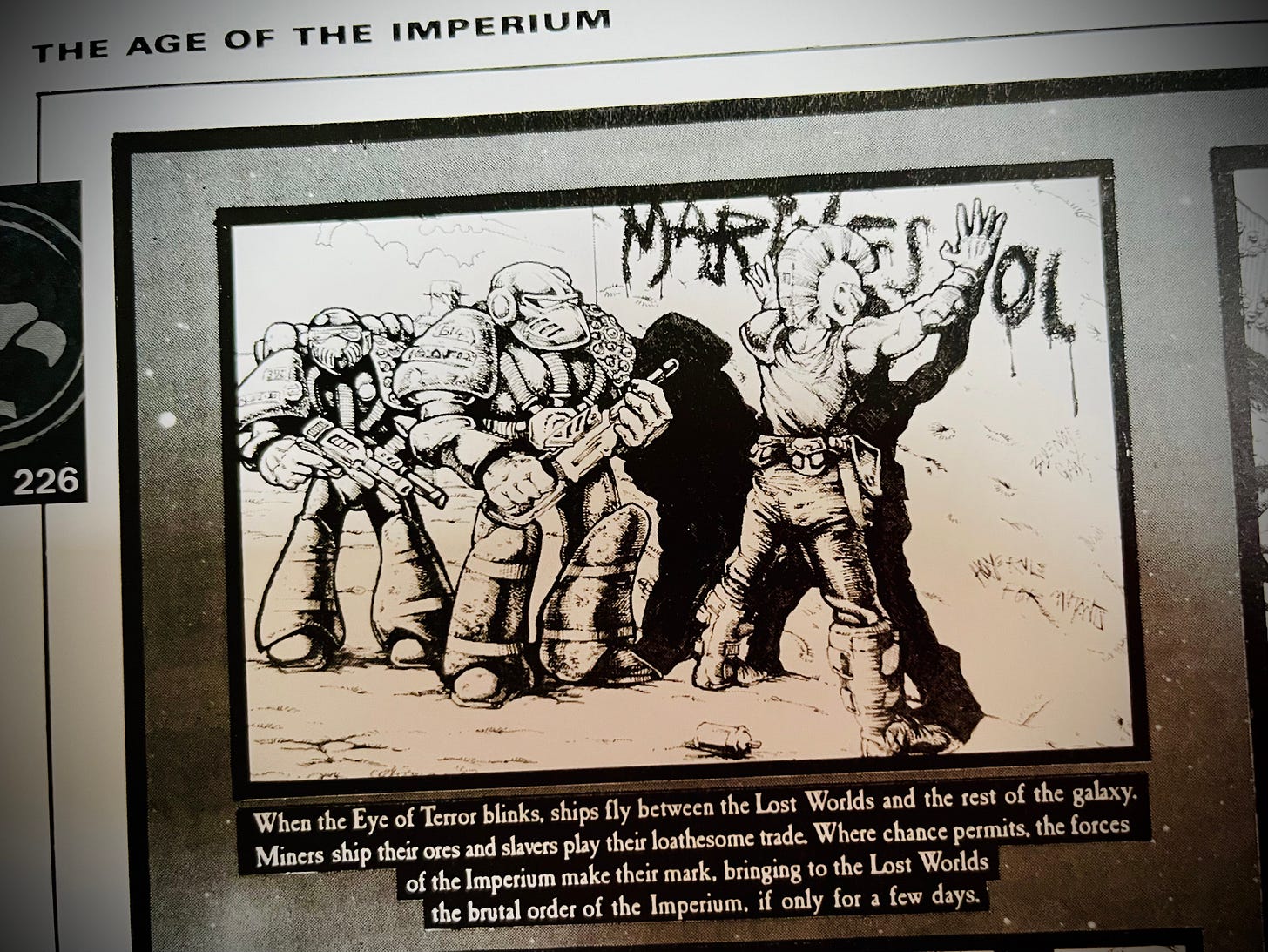Rock & Role...
Cairn! The DUNGENERATOR! 7TV! Plus we're having a monstrously good Halloween sale!
Happy halloween and all that, after a much needed week off we have a packed Gazetteer for you this week with a bookmark section alone full of enough interesting curios and strange goings on to keep you busy all weekend.
If you do want more though we’re having a special Halloween sale over on our store, and until Monday you can get 25% off everything, magazines and suitably sinister t-shirts too, with the code SPOOKYSALE.
Keep the vile vibes alive beyond Samhain with our Horror issue with its features on Vaesen, Ravenloft, Mothership and many more or perhaps dive into issue five where we explore dystopian visions of the future in games like Paranoia, Warhammer 40,000 and Bladerunner. Good fun for all the family!
Alternatively if you prefer to live an uncluttered life you can still pick up a PDF bundle of all six issues of the magazine, that’s over 600 pages of features, interviews, reviews and more from DriveThruRPG for just £6. Incroyable!
Right! That’s enough of that. Read on for more spooky tabletop tales, a look at the new second edition of Cairn, some Kickstarters you’ll definitely want to check out and everything from cursed Celtic heads to the real horrors of the tabletop game industry in bookmarks.
Finally if you like what we do here and think others may benefit from it too then please do share this as with the way things are these days and our own retreat from much of social media every little helps.
Till next week…
John x
From the likes of MB Games’ classic Which Witch?/Haunted House/Ghost Castle (delete as age/location appropriate) to more modern fare such as Arkham Horror, the macabre and morbid has always made for a popular theme for board games. But can these conglomerations of cardboard and plastic ever truly be scary?
Back in issue 3 this was a question we put to Dan Thurot, who ended up finding tabletop terror in the most unlikely of places… We’ve never posted this feature online and so to mark Halloween here it is, free to read, in all its gruesome glory.
ROLL & FRIGHT
The massacre poses some distinct problems for my long-term plans. Most of the park’s guests—those who, like me, had always harbored an interest in the archaeological—have been reduced to quivering rabbits in the face of the ancient evil we awakened with some ill-timed recitations from an excavated tablet. Now two more have been reduced to even less.
CAIRN - 2ND EDITION
Regular readers should by now be well aware of Yochai Gal’s Cairn, through both the many plugs we’ve thrown its way over the years and our unbusheled love for Gal and Brad Kerr’s Between Two Cairns podcast. This week though marks an important milestone for the game, as whilst we wait -somewhat impatiently- for the second edition’s box set to arrive both the new Player’s and Warden’s Guides have been added to Itch.io (DriveThruRPG to soon follow) and, being both free to download and the kind of game it is, could be on the table this weekend.
For those of you who haven’t already hit those links like Mike Tyson, Cairn is an RPG that essentially grew out of the OSR movement at an opportune moment, as a new generation were coming through who had fallen for what was perceived as the old school style of play but weren’t as beholden to the past, drawing their inspiration less, directly at least, from say B/X and more filtered through later games like Knave and Into The Odd.
I think it may have been Yochai himself that coined the term NSR to describe these games as they sought to differentiate themselves, and Cairn falls firmly into that camp and with its simple rules, very clear and precise principles of play and vibrant creator community has in the past four years established itself as one of the leaders of this new school pack and the new edition of Cairn itself builds upon rather than wholesale revises the original version and its deviations from the B/X template.
PCs still have three stats (STRength, DEXterity, WILlpower) and a limited set of inventory slots, attacks automatically hit dealing a certain level of damage depending on the weapon minus any armour on the target, spells are kept in grimoires and on scrolls and can be used by anyone, hit points (or rather hit protection) are a precious but easily replenished resource and characters grow through interacting with the world rather than just magically improving stats through acts of violence.
Beyond the core rules though, which essentially remain the same, the new Player’s Guide hugely fleshes out character options replacing the random tables with 20 backgrounds - such as the blacksmith like Kettlewright or fae touched Changeling - that give characters their starting equipment, certain boons and banes and more purpose and connections to the world around them.
You also get new rules and clearer procedures for wilderness and dungeon exploration, downtime and character development, essentially lots of small but important quality of life improvements that should broaden the game’s appeal. All in all it’s a great update to the first edition, packing a bit more meat on those bones without overburdening it.
The new Warden’s Guide though is just that, completely new. Here you’ll find all sorts of tools to help you run the game from a bestiary and magic list to creating and running factions and establishing the world itself, generating maps - both over- and underground - and landscapes that feel lived in and ready to be explored.
Speaking of the world, or in this case The Wald, Cairn’s second edition provides a much more concrete -if still fairly mutable- setting. Whilst things are still kept pretty loose, the game goes into much more detail of the deep dark forests, mythic underworlds and strange fairy realms that players will be exploring. A completely blank map may be more freeing for some, but it’s probably the case that most people want to have some starting idea of the world they’re running and without becoming too prescriptive Cairn now does that, giving us a lot of evocative stuff to springboard off of.
In many ways Cairn’s first edition felt like -and probably was- the cliff notes to Gal’s own home game, perfectly workable and a great starting point for those who like to go wild with the homebrew but this second edition feels much more like its actually been written for other people who don’t have that insight. Now though with a more expansive player facing section, lots of help for Wardens, its clear principles of play, useful examples and tips for handling the game’s more abstract elements, especially where it deviates from OSR orthodoxy, Cairn more than delivers on that early promise.
THE DUNGENERATOR: DIE IN A DUNGEON
We featured the original incarnation of Rollinkunz’ Dungenerator a while ago in Wyrd Science back when it was just a simple deck (or 2) of cards featuring tunnels, caverns and the like that allowed you to quickly create a stygian sandbox in no time at all. Whilst that original version was fun to mess around with it was always somewhat limited in its appeal, but fast forward to today and the artist and game designer has run with the concept turning it from an interesting novelty into a fully developed, yet still remarkably compact, game in its own right.
DIE in a Dungeon then is a complete solo/co-op deck building rogue-lite dungeon crawler that will have you creating, exploring, looting and hopefully escaping from master filled underworlds in no time. From your village base you’ll generate quests before heading below ground to battle your way through orcs, skeletons, zombies and the like, avoid deadly traps and navigate your party (represented by a set of polyhedral dice, ofc) through the mazy passageways all created one card at a time.
There’s been some great solo-games released of late, especially those that have leant heavily into the more deeply emotional, immersive side of what RPGs can be. If you fancy getting in on the action but are put off by the idea of spending an evening alone crying into your fantasy diary then DIE in a Dungeon is a great way to scratch that murder hobo itch and just engage in some senseless dungeon diving instead.
Campaign Ends: November 9
7TV FANTASY GENRE GUIDE
Wargames as we know them can trace their origins back to 18th century Prussia and the creation and development of Kriegsspiel (literally wargame) by Prussian baron George Leopold von Reisswitz and his son Georg. Designed to help military leaders develop their tactics and stop getting kicked all over Europe by Napoleon, the games’ success saw them picked up by armies around the world and, much to the recent (somewhat hilarious) consternation of some tabletop enjoyers, still put to use by militaries today.
Whilst they may have evolved out the same primordial muck as those currently employed by the military, most modern miniature wargames have increasingly little relevance to what actually happens on a battlefield and not just because they’re more likely than not to feature dragons or space wizards duking it out, but because they very rarely involve anything remotely resembling strategy or tactics beyond exploiting list building.
Neatly side-stepping any concerns about verisimilitude is Crooked Dice’s 7TV wargame. Crooked Dice you may know from their frankly incredible range of miniatures, most resembling iconic characters from 20th century TV with the serial numbers only barely filed off. Their house system leans into that, with the aim not to perfectly recreate epic battles from history or far-future conflicts but rather the conflict of action films, sci-fi series and the like.
Here you take on the role of film studios whose survival depends on hitting every trope your audience expects, creating moments of celluloid high-octane drama to keeping your viewers glued to their screens. This new expansion focuses in on glorious sword and sorcery, fantasy action, and sees you build a cast of heroic (and villainous) archetypes and kit them out in all manner of props before trying to recreate your favourite Harryhausen or Peter Jackson’esque moment.
If you’re tired of epic fantasy or sci-fi battles, supposedly for the fate of the universe but that seem to feature less combatants than your average post-pub fight in a provincial English town and fancy something a little more self-aware then 7TV’s alternative take on wargaming could be just what you’re looking for.
Campaign Ends: November 4
Finally a collection of things, both interesting and inspiring, gaming related and not, found down the back of the internet’s sofa…
How did Games Workshop’s most bankable lads, the Space Marines evolve from clownish space cops to the tacticool incel icons of today? We love a thought provoking essay here at Wyrd Science and this one is an absolute banger as, in the wake of the hugely successful video game Warhammer 40,000: Space Marine 2, Edwin Evans-Thirlwell unpacks “the hideousness of the Space Marine" [RockPaperShotgun]
Down the years there’s been several spooky TV broadcasts, like 1992’s spoof Ghostwatch, that have fallen into legend. Few excite fans of the wyrd and hauntological though as a long thought lost Nationwide report on The Hexham Heads, two curious Celtic statutes that were uncovered by children in the 1970s and led to a series of terrifying supernatural encounters. Well, just in time for Halloween, the BBC have managed to recover at least some of the footage and it makes for incredible viewing. [BBC News]
If you’re of a certain age (and I guess British) there’s a good chance that Usborne books played an outsized part of your childhood, whether it was there World of the Unknown series or their various books of Spycraft and the like that had 70s and 80s kids cooking up invisible ink in the kitchen and embarking on monster hunts. Anyway graphic designer Jon Hicks was clearly deeply affected and is currently working on a beautifully illustrated mashup of two of the books to create the Supernatural Detective’s Field Guide [Supernatural Detectives]
Chat to us for more than five minutes and we’ll probably start boring on about how much we love Dark Future, Games Workshops’ odd little car game from the late 80s. Anyway, clearing out some old folders yesterday we found our screen grabs of the now sadly deleted Setting section from the game’s Wikipedia page. Now that’s what I call world building. [BlueSky]
For those who like to really lean into the nerdier side of our hobbies then this paper by Pascal Martinolli that presents (and I’ll quote here otherwise i’ll make a right hash of it) “an in-depth historical and bibliometric analysis of academic research on tabletop role-playing games” will be like catnip. It’s fascinating to see how academic interest in RPGs has exploded in recent years but also how actually game design has always been one of the least studied areas, anyway dive in and check it out. [Pascal Martinolli]
There was a point around a year ago where the word apotropaic was being bandied around on social media almost as much as liminal. Anyway, those of you who do enjoy a spot of anti-maleficent graffiti will be interested in this report on Gainsborough Old Hall in Lincolnshire where a ‘a “staggering array” of witches’ marks and rare curses carved into the walls of the Tudor property’ have been discovered. [The Guardian]
Fans of big rubber minsters and vaguely affordable clothing rejoice as Uniqlo have just released a range of tees to mark the 70th anniversary of everyone’s favourite Tokyo terroriser Godzilla. [Uniqlo]
More odd news on the BBC with a report about the ‘discovery’ of a new Mayan city, apparently around the size of Edinburgh and home to up to 50,000 people before it was swallowed up by the jungle. [BBC News]
What happens when your influencer marketing team send a sex doll to a board game YouTube channel? This, this is what happens. [The Dragon’s Tomb / YouTube]
David Blandy and Daniel Locke have both featured in our pages individually before and hopefully at some point soon will again with their recently released RPG Eco Mofos. But before then they’re hosting an exhibition at Brighton’s Phoenix Art Space featuring artwork from the game and interactive events that tie into the game’s themes and runs until this Sunday. [Phoenix Art Space]
The tabletop games industry is frankly a bit of a shit business, filled with many lovely people doing their best but also some right sorts who for a variety of reasons seem to be able to wallet inspect the community time and time again. Anyway, on that theme over at Rascal Rowan Zeoli digs into claims of exploitation and worse at World of Game Design. [Rascal]
We cannot recommend Tim Clare’s upcoming book, The Game Changers, enough. Part historical overview of how tabletop games have been an essential part of humanity’s history, part personal story about what games mean to him, it’s a lovely, heartfelt look at something many take for granted. As you’d expect Tim’s doing the media rounds to promote it and this feature over at The Guardian about how ‘Games Can Change Your Life’ is well worth a read too. [The Guardian]
Over at Geekerati Christian Lindke looks at the much maligned board game Candy Land and how in the hands of his young daughters it has become an excellent introduction to RPGs. [Geekerati]
I promise you we do occasionally read newspapers other than The Guardian but anyway fans of the wonderful Tove Jansson and her Moomin creations will be delighted to know that a new book is set to be published featuring Jannson’s previously unseen notes on the peculiar characteristics and traits of her strong little trolls. Whilst this sadly doesn’t include stats for wargaming with the stout little creatures, those who have ever idly wondered what a Moon pelt upholstered sofa might feel like are in luck… [The Guardian]
And finally we return once again to Alec Worley’s excellent newsletter Agent of Weird for a heartfelt defence of the oft derided British sword & sorcery film Hawk the Slayer (and congratulations to everyone repeating lines from Spaced right now, I hope your backs are doing well in middle age). [Agent of Weird]














